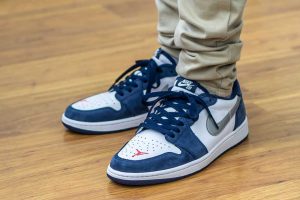I get a lot of questions revolving around comparative sizing. People want to know if they can buy the same size in different models. Here, we break down the difference in fit with respect to Air Jordan 1 vs Air Force 1 sizing.
Air Force 1 And Air Jordan 1 Don’t Fit The Same
The Air Force 1 and Air Jordan 1 fit differently. While both sneakers technically run true to size, Jordan 1s have a narrower fit while Air Force 1s have a roomier fit.

These have the traditional “big”
fit of the Air Force 1
Air Force 1 sizing can often throw off those that are used to wearing Air Jordan 1s and other Nikes. While getting your true size in either shoe is a safe bet as far as sizing goes, the sneakers feel radically different on foot.
Generally speaking, Air Jordan 1s have a snug and somewhat narrow fit. You can tell just by looking at the sneaker from the top that the shoe is more “shapely”. While some versions of the model are a bit more generous in width, the overall feel is still the same. Jordan 1s are not known for their comfort.
Meanwhile, the Air Force 1 has a roomier fit. This can feel loose on some people’s feet at true to size. While this may not warrant going down a full size, you might consider it based on materials. A pair of AF1s with a softer upper might fit a little better at a half size down.
You can look up Nike’s official size chart here, or try my new shoe size calculator.
Size Up Or Down In Jordan 1, Or Go True To Size?
Air Jordan 1s fit true to size. Older releases of the model can be more snug than newer releases, depending on how soft the materials are. For wide footers, going a half size up will help alleviate this.

This sneaker is more forgiving on width
than older AJ1s, but not by much
The Air Jordan 1 is tricky with respect to sizing. While the sneaker technically “fits” at true to size, the feel on foot is often cramped, particularly on older releases. This of course can be broken in with a few wears, but I personally find Air Jordan 1s to take a bit longer to break in than other non-Jordan Nike releases.
This odd, narrow sizing is slightly less of an issue with newer Air Jordan 1s.
Regardless what the year of release is though, the sneaker does not rank highly in comfort. In fact, the Jordan 1 is notoriously uncomfortable until broken in. I don’t recommend walking around too much in a new pair. Once the uppers soften up and conform to your foot, they are safer to wear for longer periods of time.
With all that said, some find going a half size up to be helpful in alleviating break-in pain. The downsides of this are that the shoe will fit excessively long and crease more easily. For me, the compromise is worth it depending on which release we are talking about.
Air Jordan 1 Low Vs High Fit
The Jordan 1 has a narrow fit at true to size whether the cut is high, mid or low. Jordan 1 lows don’t have the ankle support of the highs, but fit about the same as far as width and length.

These might feel “bigger” due to less
constriction around the ankle, but
length/width is the same
The Jordan 1 low definitely has less going on with it overall and might feel as though it has a roomier fit than the AJ1 high. However, the interior dimensions of both are the same.
Jordan 1 lows trade the ankle support and recognizable style of the highs for casual appeal and ease of use. There’s simply less to lace up. I find that I can lace up a pair of AJ1 lows and then just slip my foot in and out of the shoe as needed moving forward. With the highs, the top eyelets need to be unlaced and relaced every time the sneaker is worn/taken off.
That said, the same narrow fit of the highs persists with the lows. So the same rules apply: allow the sneaker to break in for maximum comfort, and consider going a half size up if your feet are on the wider side.
Additionally, newer models might not suffer from as narrow a fit as older releases but will still be on the skinny side. The “old style” Jordan 1 lows with Nike Air on the tongue will have less padding and a more forgiving fit, while the “new style” versions with a Jumpman on the tongue are more heavily padded. The additional padding will affect how much room there is in the interior of the shoe.
Air Force Ones make your feet look big
Air Force 1s have a taller and wider fit with a rounder toebox than many other Nikes. This results in looking larger on feet. Pants choice can either reduce or accentuate the sneaker’s looks.

I had to go a half size down in these.
They still look huge when combined
with skinny jeans.
Since we are talking about sizing, we should mention how these kicks actually look on feet. Do they LOOK like they fit big?
Before I knew what my true size actually was, I used to go with what wound up being a half size up in Air Force 1s. This resulted in me having to “choke” or tightly lace the sneaker in order to keep it on my feet! While this isn’t technically an issue, and is still comfortable, it’s not my preference aesthetically. Over time, I experimented with sizing and found that for my foot shape, true to size or even a half size down worked best.
Unlike the Air Jordan 1, I find AF1s to fit similar regardless of release year even though the shape fluctuates over time. Also unlike the AJ1, these fit very comfortably right out of the box widthwise.
Given that the Air Force 1 sizing is on the big side, going down half a size can cut down on the hugeness of the sneaker. However, it will still have that rounded toe shape and tall midsole which makes the shoe look relatively big on feet.
A solution to this (if it bothers you) is to wear baggier pants, or at least pants that don’t have a dramatic taper. If the leg and ankle area looks slightly larger, it reduces how big the sneakers look. Personally I prefer more of a slim fit vs a skinny jean when wearing some Forces. This, combined with going down a half size, results in a comfortable and not-too-extreme look.
Overall, AF1s and AJ1s feel and look different on feet, even if you get the same size in both. Both also present classic looks, however the seasoned sneakerhead will keep in mind that Air Force 1 sizing and on-foot appearance is generally on the larger side vs other Nikes.
Buy Air Jordan 1s & Air Force 1s:
| Shop Air Jordan 1s | Shop Air Force 1s |
|---|---|
| Air Jordan 1s on eBay | Air Force 1s on eBay |
